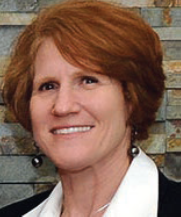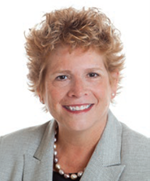‘It’s on us’: Health care’s unique position in the response to human trafficking
Adapted with permission from The Rural Monitor
Before joining the board of Transitions of Pennsylvania, a local women’s resource center, Kendra Aucker says human trafficking wasn’t exactly on her radar.
“I live in an idyllic part of the state, but I’ve learned that it happens right here. I mean, there are people right here who traffic their own children,” says Aucker, who also serves as CEO of Evangelical Community Hospital in Lewisburg.
“What really opened my eyes was learning that up to 88 percent of survivors indicated that they sought health care during the time they were trafficked,” recalls Aucker.
The reality of human trafficking
Human trafficking, as defined by the U.S. Department of Homeland Security, “involves force, fraud, or coercion to obtain some type of labor or commercial sex act.” Referred to as a form of “modern-day slavery,” human trafficking occurs in every state and is not limited by the size of a community. It has been identified as a public health concern by researchers, federal agents, and health care professionals.
“This is a social issue in our communities and, as human beings, we have the responsibility to treat human trafficking as the crisis it is and to do our part to tell the story and make a difference,” Aucker says.
Types of human trafficking
The two most common forms of human trafficking, as defined by the Trafficking Victims Protection Act of 2000:
Sex trafficking: A commercial sex act induced by force, fraud or coercion, or in which the person induced to perform such an act has not attained 18 years of age.
Labor trafficking: The recruitment, harboring, transportation, provision, or obtaining of a person for labor or services, through the use of force, fraud, or coercion for the purpose of subjection to involuntary servitude, peonage, debt bondage, or slavery.
Polaris is a federally funded nonprofit that maintains one of the most extensive data sets on the issue of human trafficking in the United States. Informing the data are thousands of calls, texts, and messages that are fielded by its National Human Trafficking Hotline. Polaris’ latest statistics indicate that human trafficking has continued to rise, from 7,748 confirmed cases reported to the hotline in 2016 to 10,949 in 2018. Polaris’ demographic breakdown shows that nearly half of survivors are minors, there are five times more females trafficked than males, and minorities are more likely to be trafficked.
The federal Trafficking Victims Protection Act of 2000 differentiates between sex and labor trafficking but pegs the former as the most common by nearly 8:1. Both have been identified as problems in rural America, but definitive statistics are lacking. What is known is that the characteristics of many rural locations make them attractive to traffickers passing through or looking to set up shop. A secluded location, away from heavy legal forces and home to vulnerable populations, can be the perfect haven for traffickers.
 Lisa Davis |
Lisa Davis is the director for the Pennsylvania Office of Rural Health and is a driving force in the effort to educate rural health care facilities on the reality of human trafficking.
“The stories I’ve heard are gutwrenching, but they are all over the map,” says Davis, who went on to describe desperate situations that become advantageous for human traffickers: a young girl who has run away from home, a migrant worker with a dream of a better life, someone with a substance use disorder looking for relief, a desperate mother who can’t pay rent.
The Pennsylvania office’s efforts have served as a model for other state offices of rural health, with the first Pennsylvania Rural Human Trafficking Summit in 2019 to raise awareness and train health care providers.
Preying on the vulnerable
Individuals who are trafficked in rural areas have vulnerabilities, such as recent migration or relocation, single motherhood, recent contact with the child welfare system, a substance dependency, homelessness, or mental health conditions. Often, the victim already has a relationship with the perpetrator who has taken advantage of their trust and targeted their vulnerabilities to create dependency.
 Anne Boatright |
The Nebraska Hospital Association (NHA) created a human trafficking toolkit to be a practical guide for health care systems to help identify human trafficking and develop a standard policy to address it. At the start, NHA sought out professionals with varying expertise to give input, including Anne Boatright, a practicing sexual assault nurse examiner (SANE).
Boatright has trained more than 3,000 Nebraska medical providers, the majority of whom practice in rural areas, on human trafficking identification. She commends the toolkit, which has helped her quickly disseminate the information.
“Many think of human trafficking happening only in urban areas to people who are abducted and held against their will,” Boatright explains. “But we aren’t seeing that a lot. We see those with a vulnerability and someone exploiting the vulnerable because they have the ability to do so.”
Lisa Lohnes has lived and worked among vulnerable populations in rural Minnesota. She is currently one of eight Safe Harbor Regional Navigators, part of a program funded by the state of Minnesota. Lohnes serves as the main point of contact for connecting sexually exploited youth and adults to human services.
Lohnes grew up in Minnesota’s Cass Lake, home of Leech Lake Indian Reservation, and is a member of the Spirit Lake, Mni Wakan Oyate tribe. She has seen sexual exploitation firsthand. “They’re desperate, so they trade sex for drugs, products, and even food that they need. And sex traffickers are master manipulators, so they tend to target the vulnerable,” she says.
She went on to explain what researchers and public health professionals agree is often at the root of exploitation: “Historical trauma and intergenerational trauma create a loss of hope. They don’t see a way out. That’s where survival sex comes in — something that happens a lot with these communities. Not everybody is provided opportunities, so we try to make a way out for them.” Homelessness is a big factor that contributes to sexual exploitation in northwest Minnesota, so Lohnes and her team coordinate with transportation services, homeless shelters, transitional housing, and mental health providers.
"Historical trauma and intergenerational trauma create a loss of hope. They don’t see a way out. That’s where survival sex comes in — something that happens a lot with these communities. Not everybody is provided opportunities, so we try to make a way out for them."
Like many human service organizations, Support Within Reach offers trainings to communities and professionals such as law enforcement and health care providers. Right now, the pandemic has moved their trainings online, allowing them to reach more groups of people at a faster rate.
Rural providers uniquely positioned
Health care providers have a valuable role to play in the identification of human trafficking victims and the provision of their physical and psychological care. Survivor records from 2018 indicate that health services were one of the most common points of access to a lifeline for those actively being trafficked, along with family, friends, and law enforcement.
Sexually transmitted diseases, urinary tract infections, pregnancy, and physical injuries are just a few reasons for appointments or emergency room admissions. But the signs aren’t always recognized. “One former trafficked person was in a hospital 17 times before someone noticed there was something else wrong,” Davis says.
Boatright says some of the indications are more obvious than others, such as an unusual tattoo, malnourishment, and evidence of injury. Others may be related to the guardian, such as large age gap, insistence on being present during an exam, or controlling the patient’s identification card. A hotel key or large amounts of cash may also warrant suspicion.
“It’s ultimately about power and control for these traffickers,” Boatright explains. “But it’s not unusual for nurses or physicians to miss these signs. When I was regularly identifying trafficked persons, there would be times where I knew something was wrong, but I didn’t know quite what it was or how to name it. It’s common for medical personnel to have similar feelings. I try to teach people to follow their gut and know where to go with it.”
One challenge is that trafficked persons may not recognize that their situation qualifies as trafficking. For instance, they may say that they can’t afford to leave their boyfriend or that an uncle is making them sleep with a drug dealer for cheaper drugs. Providers can help their patients self-identify by asking the right questions. At the same time, Boatright reminds health care providers that their job is not to act as investigators but to provide trauma-informed health care to build trust so that the victim feels comfortable opening up about their reality.
 Kendra Aucker |
Leading a systemwide response
After learning about the reality of human trafficking in Pennsylvania, Aucker immediately started implementing systemwide changes throughout Evangelical Community Hospital in 2018. She started with a mandatory training for her staff, followed by voluntary trainings from a third-party expert.
“It was probably one of the most profound trainings that we have ever done. People were texting their family members calling for family meetings. People got emotional. I think when you talk about what human trafficking is, people think about their wives, their daughters, and their neighbors because it’s modern slavery — force, fraud, or coercion — people were appalled by it. And so, it lit my workforce.”
Aucker and her team recruited champions within the facility to lead the charge. An on-call system with SANE nurses and a screening assessment were created to help clinic and hospital staff accurately identify a trafficked person.
Now, they’re working with larger health care systems to adopt the training throughout those systems.
“What Kendra has done can be replicated in any hospital, regardless of geography,” Davis says.
Since launching the plan, Evangelical Community Hospital has successfully identified ten trafficked persons, contributing to 621 victims identified in Pennsylvania.
An intentional approach
These trauma-informed steps, outlined in the Nebraska Hospital Association’s Human Trafficking Toolkit, can be the first steps to help a victim out of a harmful situation.
- Provide a quiet, safe place for the patient
- Separate any companions from the patient
- Attend to the physical needs
- Adopt an open, non-threatening body position
- Engage the patient
Aucker gives the credit to her staff: “It’s one of the benefits of being a community hospital. I now have nearly 2,000 individuals who have this on their radar and who are speaking out about this.”
Where do we go from here?
One of the first steps to address human trafficking on the local level, Aucker suggests, is for people in leadership positions to get educated: “An administrator of a hospital is a leader who can give a voice to this. That’s your responsibility. The rest is already out there to aid you in developing a program for your organization.”
Once identified, trafficked persons will need a line of support services if they are to successfully break away from their perpetrators. “If we fail to get them the help they need, they may end up back in this situation,” warns Boatright. Psychological trauma such as post-traumatic stress disorder commonly follows survivors of human trafficking. If in-house therapy is not offered, immediate referrals to a tertiary care center is important for healing.
Connecting to community groups that can provide multidisciplinary efforts to address human trafficking can also pay off. Child protective services, human services organizations like law enforcement, and state patrol all have a vital role to play.
On the state level, Davis advocates that rural health organizations have a responsibility to train their health care facilities and staff. “I think state offices of rural health are in a unique position because they know their rural communities and their rural health care leaders and are a respected source of information,” Davis says. “They also have forums in which they can speak collectively and stress that human trafficking is a rural concern, and it is a responsibility of a health care delivery system to raise awareness and serve as a point of intervention.”
